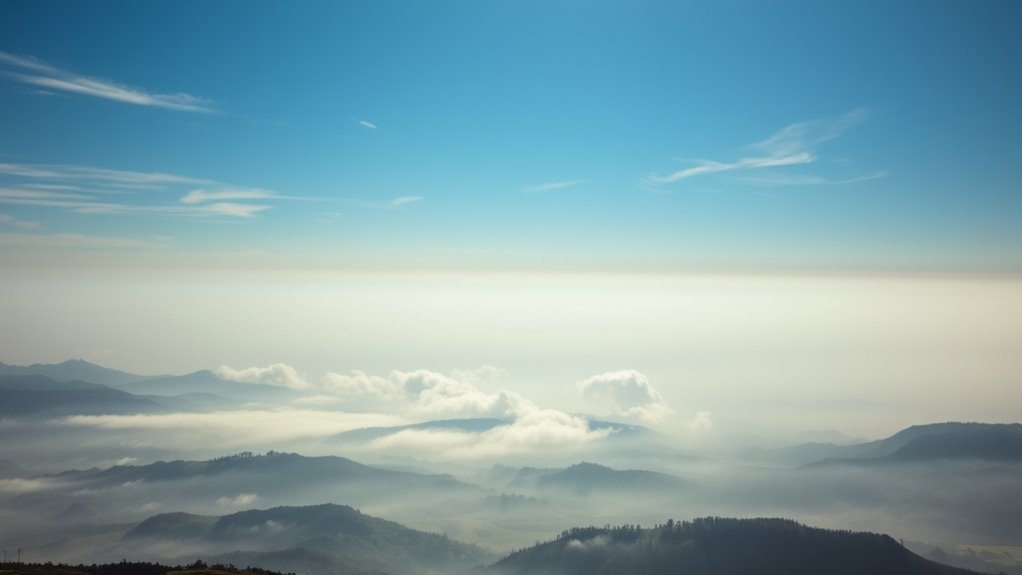To recognize inversion layers, look for clear, calm nights or mornings when a warm air layer sits above cooler ground-level air, trapping pollutants and causing haze or smog. These layers often form in valleys or during slow weather changes and can lead to poor air quality. Understanding these signs helps you identify potential pollution traps. If you want to learn how to better avoid or cope with these conditions, there’s more to uncover ahead.
Key Takeaways
- Recognize inversion layers by sudden drops in temperature with height and limited vertical air movement.
- Inversions often form during clear, calm nights or mornings, especially in valleys and cold regions.
- Weather shifts like wind increases or cloud cover can signal the breakdown of an inversion.
- During inversion conditions, expect trapped pollutants near the ground, leading to smog and poor air quality.
- To avoid pollution traps, monitor weather forecasts and stay indoors or use air purifiers during inversion episodes.

Have you ever wondered why pollution sometimes lingers in the air or why temperatures suddenly drop at certain times? The answer often lies in the phenomenon called temperature stratification, which is a key component of inversion layers. Normally, air near the ground is warmer than the air above it, allowing the warm air to rise and disperse pollutants. However, during an inversion, a layer of warmer air sits on top of cooler air near the surface. This inversion acts like a cap, trapping the cooler, denser air below. As a result, any pollution, dust, or smoke released into the atmosphere can’t escape upwards and becomes concentrated near the ground. This process is what we call pollution trapping. It’s why smog can become so thick during certain weather conditions, especially in urban areas or valleys where the terrain prevents air movement.
Temperature inversions trap cool air and pollution near the ground, causing smog and poor air quality.
Temperature stratification during an inversion layer creates a stable atmospheric situation. The warm air aloft prevents the vertical mixing of air, effectively sealing in pollutants below. Because of this, pollutants accumulate and can reach dangerous levels, impacting air quality and health. When the inversion persists, it can lead to prolonged periods of poor air quality, sometimes lasting days. Conversely, when the inversion breaks, the warm air aloft mixes with the cooler air below, dispersing the pollutants and restoring healthier air conditions. This shift often happens with changes in weather, such as wind shifts or cloud cover, which break apart the stable stratification.
Understanding the dynamics of inversion layers helps you recognize when pollution might be trapped in the atmosphere. For example, during early mornings or winter nights, inversion layers are more common because the ground cools rapidly, cooling the air close to it. As the sun rises and heats the ground, the temperature gradient breaks down, dispersing pollutants. If you’re in a city experiencing persistent fog or smog, it’s likely due to such temperature stratification caused by an inversion layer. Recognizing these signs can help you avoid spending extended periods outdoors during high pollution episodes or take precautions to minimize health risks.
In essence, the key to avoiding the negative effects of inversion layers is understanding their formation and timing. When you see weather reports warning of temperature inversions, be aware that pollution trapping could lead to unhealthy air quality. By staying indoors or ventilating your space when inversion conditions are present, you can reduce your exposure. Knowing how temperature stratification influences pollution dispersion empowers you to better interpret air quality patterns and make safer choices, especially during seasons or weather conditions prone to trapping pollutants. Additionally, HEPA filtration in air purifiers can help remove residual pollutants from indoor air during such episodes, providing an extra layer of protection.
Frequently Asked Questions
How Do Inversion Layers Form Over Urban Areas?
You might notice inversion layers over urban areas when the surface heats up during the day, creating urban heat. This warm air traps cooler, polluted air beneath it, causing pollution buildup and trapping smog. At night, the heat escapes, but during the day, the inversion forms as the cooler air stays close to the ground, preventing pollution from dispersing. This process worsens air quality and can trap pollutants close to the surface.
What Are the Signs of an Impending Inversion Trap?
A stitch in time saves nine, and spotting inversion indicators early can save you trouble. Signs of an impending inversion trap include a sudden drop in temperature, clear skies, and still air. Look for a rapid temperature inversion, where warmer air sits above cooler air, trapping pollutants. If you notice these signs, you should stay alert, as they warn of a developing temperature inversion that can cause poor air quality and trapping of pollutants.
Can Inversion Layers Affect Local Weather Predictions?
Yes, inversion layers can affect your local weather predictions by impacting pollution dispersion and temperature stability. When an inversion occurs, it traps pollutants close to the ground, leading to poor air quality, and stabilizes temperatures, preventing normal mixing of air layers. This makes forecasting more challenging, as conditions may persist longer than expected. Recognizing these effects helps you anticipate how inversion layers can influence local weather and air quality.
How Do Inversion Layers Influence Air Quality?
Inversion layers trap pollution close to the ground, reducing pollution dispersion and causing smog to accumulate. This buildup worsens air quality and can lead to serious health impacts, especially for vulnerable populations. When you’re under an inversion, expect higher concentrations of pollutants, which can trigger respiratory issues, allergies, and other health problems. Recognizing this helps you stay cautious and limit outdoor activities during such conditions.
Are Inversion Layers More Common in Certain Climates?
You’ll find inversion layers more common in mountain valleys and urban heat areas. In mountain valleys, cooler air settles beneath warmer air, creating frequent inversions. Urban heat islands trap cold air near the ground, making inversions more likely, especially on calm, clear nights. These climates foster stable atmospheric conditions, increasing the chances of inversion layers forming and impacting air quality. So, pay attention to these environments when evaluating inversion risks.
Conclusion
Understanding inversion layers is like maneuvering a hidden maze in the sky. When you recognize their signs, you can steer clear of the traps they set, avoiding false calm and dangerous surprises. Think of these layers as secret guardians that mask the true weather, whispering warnings if you listen carefully. By staying alert and respecting their power, you become a savvy explorer of the atmospheric maze, ensuring your journey is safe and clear, free from unforeseen storms lurking just above.









